Ebrahim Raisi, Iran’s President and a top contender to succeed the nation’s supreme leader, was killed on Sunday in a helicopter crash. He was 63.
A conservative Shia Muslim cleric who had a hand in some of the most brutal crackdowns on opponents of the Islamic Republic, Raisi was a protégé of Iran’s supreme leader, Ayatollah Ali Khamenei, and a devoted upholder of religious rule in the country.
Raisi’s presidency was shaped by two major events: the 2022 nationwide uprising, led by women and girls, demanding the end to the Islamic Republic’s rule and the government’s brutal crushing of that movement; and the current West Asia war with Israel, with which it had a long history of clandestine attacks.
As the President under Iran’s political system, Raisi did not set the country’s nuclear or regional policy. But he inherited a government that was steadily expanding its regional influence through a network of proxy militia groups and a nuclear programme that was rapidly advancing to weapons-grade uranium enrichment levels following the US’s exit from a nuclear deal.
Raisi endorsed and supported both of these policies and viewed them as essential for Iran to maintain its influence in the region and to exercise leverage over the West.
His death came as a yearslong shadow war became one of direct confrontation in the wake of Israel’s military assault on Gaza in retaliation for the October 7 Hamas attacks on Israel.
Raisi was born in the northeastern city of Mashhad to a family of clerics, and he studied at the country’s famous seminary in Qum before participating as an 18-year-old in the 1979 Islamic revolution, which deposed Iran’s shah. Just two years later, Raisi became a judge in the newly created Islamic Republic, beginning a steady ascent to the top of Iranian politics.
Like Khamenei and his predecessor, Ayatollah Ruhollah Khomeini, the founder of the Islamic revolution, Raisi donned a cleric’s black turban, one that is reserved for “sayyids”, or people who trace their lineage back to Prophet Muhammad.
The issue of succession in Iran has become more pressing because Khamenei is 85 and frail. The selection of the next supreme leader is an opaque process of political rivalries and jockeying. Under the Constitution, an elected body of clerics called the Assembly of Experts picks the supreme leader.
Raisi was viewed as one of the top contenders for that role and was favoured by the hardline faction, as was Ayatollah Khamenei’s son Mojtaba, an influential cleric who helps run his father’s office. Raisi’s death essentially paves the path for Mojtaba to succeed his father.
Political analysts described Raisi as a loyal enforcer of Khamenei’s policies and a facilitator of the growing power of the Islamic Revolutionary Guard Corps in Iran’s politics and economy.
“He was not someone exuding charisma. His speeches were not motivating people to the streets. He was executing policy,” said Sanam Vakil, director of the Middle East and North Africa programme at Chatham House. “Above all, he was a regime insider. He was an ideologue who worked within the system and through the system.”
Raisi’s supporters, including conservative pundits on state media, praised him for reimposing strict religious and social rules, being intolerant of dissent and turning Iran’s policies away from the West towards more engagement with Russia and China.
From 2016 to 2019, Raisi was at the helm of Astan Quds Razavi, a powerful multibillion-dollar religious conglomerate under the control of Khamenei and believed to be one of his most significant sources of wealth.
In 2019, Raisi became the head of Iran’s judiciary, and during his tenure he oversaw some of the most brutal crackdowns on dissent. At least 500 people were killed during nationwide demonstrations in November 2019 in response to a spike in fuel prices. The judiciary arrested activists, journalists, lawyers and dual national citizens.
He became President in 2021 in an election that was widely seen as orchestrated to ensure his victory, with his most serious rivals having been disqualified.
Raisi campaigned as an anti-corruption candidate but took up the presidency under a cloud of condemnation by government opponents and international rights groups. Rights groups highlighted Raisi’s background as a member of a four-person panel that ordered the execution of 5,000 political dissidents in 1988 without trials at the end of the Iran-Iraq war. Raisi has not denied being part of the panel and said in a speech that he was a junior official appointed to the role by the supreme leader at the time.
“We lost a generation of political minds and activists who could have been important players in Iranian society,” said Hadi Ghaemi, executive director of the Centre for Human Rights in Iran.
Raisi, he argued, played a hand in several of the most repressive moments of Iranian history, in particular the crackdowns on anti-government protests in 2009 and 2022.
Raisi took power three years after Donald J. Trump, as US President, withdrew from the nuclear deal between Iran and world powers. After the US exited the deal, Trump reimposed tough economic sanctions on Iran, hitting the country’s oil sales and banks. A year later, after Iran failed to reap the benefits of the nuclear deal, it returned to enriching uranium at a near weapons-grade level.
Raisi took office promising to pursue a “resistance diplomacy”, meaning a defiance of western powers but an openness to negotiations, particularly with the US, to return to the nuclear deal and to seek the removal of sanctions. But months of negotiations fell through in the autumn of 2021, and no deal has been reached with the Joe Biden administration.
One of Raisi’s most important foreign policy achievements as President was one that had long eluded his predecessors: the restoration of ties with Iran’s longtime regional adversary, Saudi Arabia. In 2023, the two nations signed a deal in Beijing to re-establish diplomatic relations. Although largely symbolic, the agreement was seen as key to defusing their regional rivalry.
Raisi prioritised forging closer relations with Russia and China and pivoting away from the West, saying that Iran could not trust the US and Europe after the collapse of the nuclear deal. Raisi’s government reached a sweeping 25-year economic, security and military deal with China: Iran agreed to sell Beijing discounted oil in exchange for $400 billion investments in Iran by Chinese companies in a wide range of sectors.
He also travelled to Moscow frequently to meet his Russian counterpart, President Vladimir V. Putin, and they deepened security and military relations. Iran has sold drones to Russia, which has used them in its war in Ukraine, although Raisi has denied this role.
Raisi’s impact on domestic policy during his presidency has been felt far more deeply, and his legacy is likely to be a contested one. During his rule, the country suffered severe economic downturns, driven by international sanctions and high unemployment.
“If you want to think of his legacy, he left the country’s economy in ruins, and it has become more repressive,” said Sina Azodi, a lecturer on Iran at George Washington University. “Iran was never democratic or free, but, since 2021, political repression has increased. No voice of dissent is tolerated.”
Under Raisi’s watch, Iran’s currency plunged to a record low, climate change and mismanagement intensified water shortages, and the country was hit in January by the deadliest terrorist attack since the 1979 founding of the republic.
Raisi also oversaw a brutal crackdown on anti-government protests that erupted in 2022 after the death of a 21-year-old Kurdish woman, Mahsa Amini, while she was in the custody of Iran’s morality police. Her death set off a wave of protests led by women who took off their headscarves and called for the overthrow of the Islamic Republic.
After many Iranian women defied the mandatory hijab rule and appeared in public for over a year without covering their hair, Raisi announced this spring that he was going to re-enforce the hijab rule.
His government dispatched the morality police back on the streets in April, after having earlier said the force was abolished, and many arrests of women turned violent.
Allegations of human rights abuses, for which the US imposed sanctions on Raisi in 2019, dogged him on the international stage until the last years of his life.
Last December, he cancelled a visit to the UN in Geneva amid concerns that he could face arrest over his alleged role in the 1988 mass executions because Sweden had prosecuted a more junior Iranian judiciary official under crimes against humanity.
But Raisi did attend the UN General Assembly in New York every year, delivering heated speeches that blamed the dissent in Iran on foreign enemies while portraying his country as a model of good governance and as an upholder of human rights.
New York Times News Service











